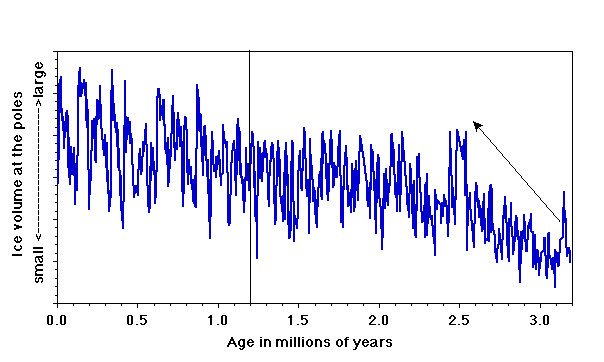
During the last few millions of years there were many alternations of glacial and interglacial times, times of expansion and contraction of the polar ice caps. During this lecture we will not discuss how we measure past ice volume: we will get to that in the upcoming weeks. This week we will look at the pattern of fluctuations in ice volume.
The changes in ice volume were cyclical, with a rather complex periodicity. Such a periodicity can be produced by adding up three wave functions, which a wavelength of about 100,000, 41,000 and 23,000-19,000 years (as in adding up the wave functions in biorhythm analysis). These waves represent increases and decreases in solar energy as seen at a specific location on Earth.
The three periodicities are well-known to astronomers, because they describe irregularities in the pattern of the Earth's motion around the Sun (and are therefore called orbital parameters). These irregularities are caused by the gravitational effects of the other planets circling the Sun.
Such irregularities cause fluctuations not in how much solar energy is received by the whole Earth, but in how much solar energy is received at a specific latitude on Earth, or in the distribution of solar energy by latitude and by season. The three periodicities are commonly called Milankovich periodicities, after the Serbian mathematician who calculated them in the 1930s, and thought they might have caused ice ages, by causing small differences in the amount of solar energy (insolation) that reaches the Earth at the high latitudes where the ice sheets form. The idea behind this theory is that in order to form a large ice sheet much snow must accumulate in the winter, which can not melt in the summer. If we thus have a fairly cool summer, but not too cold a winter, ice sheets can be expected to grow. Winter should not be too cold, because at very low temperatures the atmosphere can not contain much water vapor, so that no snow can fall.
First, we have to know how the Earth moves around the Sun, in its elliptical orbit. The earth's axis is inclined and not at right angles with the plane through the orbit. This inclination (about 23.5o) results in the seasons: the southern hemisphere is tiled towards the Sun during its summer which occurs during northern hemisphere winter, and the reverse. Days are longer, nights shorter on the hemisphere that is turned towards the Sun. Twice a year, in the equinoxes, day and night have the same length. During the northern hemisphere winter solstice, the shortest day occurs on the northern hemisphere and the longest day on the southern hemisphere; during the northern hemisphere summer solstice the day is longest on the northern hemisphere, shortest on the southern hemisphere. This regular patterns of motion, however, is changed because of the disturbance of gravity of the Earth by the presence of the other planets.
The three orbital parameters are:
The Milankovich theory states that ice caps at the poles increased and decreased in size as a reflection of the solar energy received at fairly high latitudes; the insolation at 65oN is commonly used to look at the waxing and waning of ice sheets. For a nice computer visualization of how insolation changed over the northern hemispheric polar region, click here.
We have now observed in very many different records that ice volume over the last few millions years indeed waxes and wanes on the time scales of irregularities in the Earth's orbit, and that the northern hemispheric insolation, not the insolation of the southern hemisphere, appears to drive the process. For instance, we now have relatively warm winters on the northern hemisphere (because these winters occur when the earth is close to the Sun), and our winters are colder because we arecfar away from the sun when our side of the planet is tilted away from the Sun.
The fact that the history of ice volume occurred at these orbital frequencies implicates the differences in insolation in triggering ice ages, but very many questions remain.
We are therefore not sure of the exact causes of the ice ages. Milankovich differences in insolation were the trigger, but many other feedback mechanisms probably operated. Some simple ones are:
The complexity of perceived climate change in glacial-interglacial times is increasing rapidly with more and more knowledge. A more detailed knowledge of the way in which the ocean-atmosphere system works, and of the role of the biosphere in shaping climate (by its effects on the carbon cycle) is needed before we can begin to understand even this latest, best-known part of Earth history.
Measure of ice volume on Earth. Notice the increase of ice volume staring at about 3.0 Ma, and the increase in the amplitude as well as timing of the major climate swings at about 1.2 Ma.
